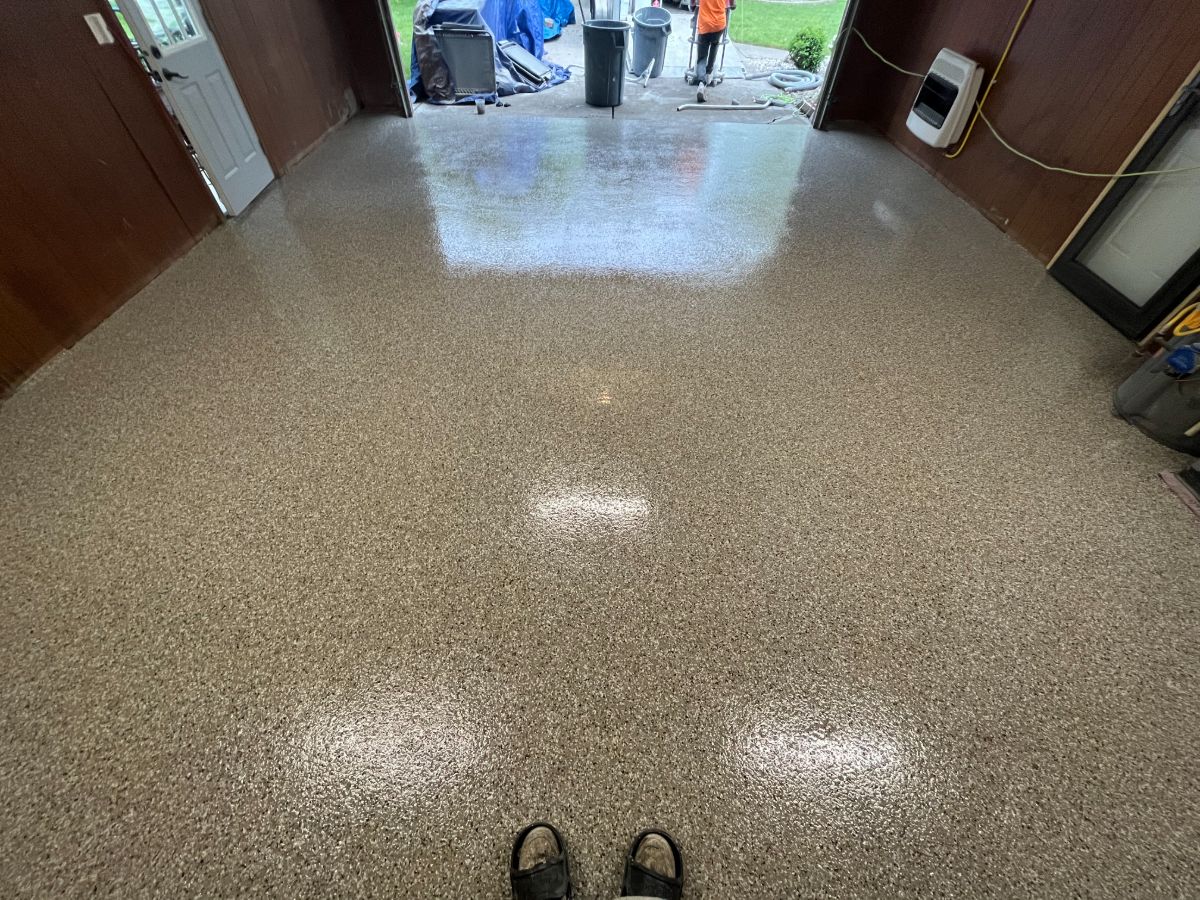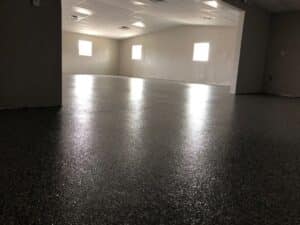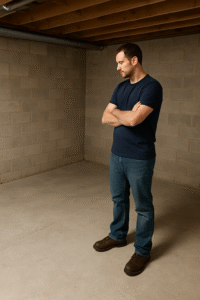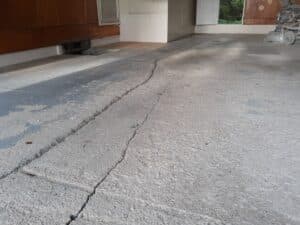Concrete floors in Upstate New York take a beating once winter settles in. One week it’s 55 degrees and raining, the next it’s single digits with ice piled up outside your garage.
Those swings are brutal on concrete, and even worse on traditional concrete coatings. That’s why so many epoxy floors start peeling or cracking by their second winter.
Polyaspartic coatings are different. Here’s why.
Quick Takeaways
- Freeze–thaw cycles cause concrete to expand and contract slightly. This contributes to cracks if not installed properly. Rigid concrete coatings like traditional epoxy will crack or delaminate from this stress–they simply can’t handle those small movements of the underlying concrete.
- Polyaspartic coatings are slightly flexible, moving with your concrete instead of against it. While extremely durable, that small amount of flexibility makes a huge difference in long-term performance. They resist salt, snowmelt, gas, and oil, all common winter hazards in Upstate NY garages.
- With polyaspartic, you can also walk on your floor the same day it’s installed and park your car inside the next.
- Dream Floors installs polyurea + polyaspartic systems across Upstate NY for year-round durability.
Why Concrete Cracks in Cold Climates
Concrete acts a bit like a sponge. It has pores and small openings that allow water to creep in. Once the temperature drops outdoors, that trapped moisture freezes and expands with surprising force.
The frozen water pushes outward, breaking apart the surface grain by grain, ever so slightly.
When temperatures swing back up, the ice melts and leaves new pathways for more water. Multiply this by dozens of freeze–thaw cycles each winter, and even strong concrete can’t hold up perfectly. And it’s not just a winter issue either. When summer heat pushes temperatures into the 80s and 90s, the slab expands, then contracts again when the evenings cool down. That constant shifting means the concrete is always moving a little, no matter the season.
You can see that while our winters are a problem for concrete coatings, the summers can be just as tough.
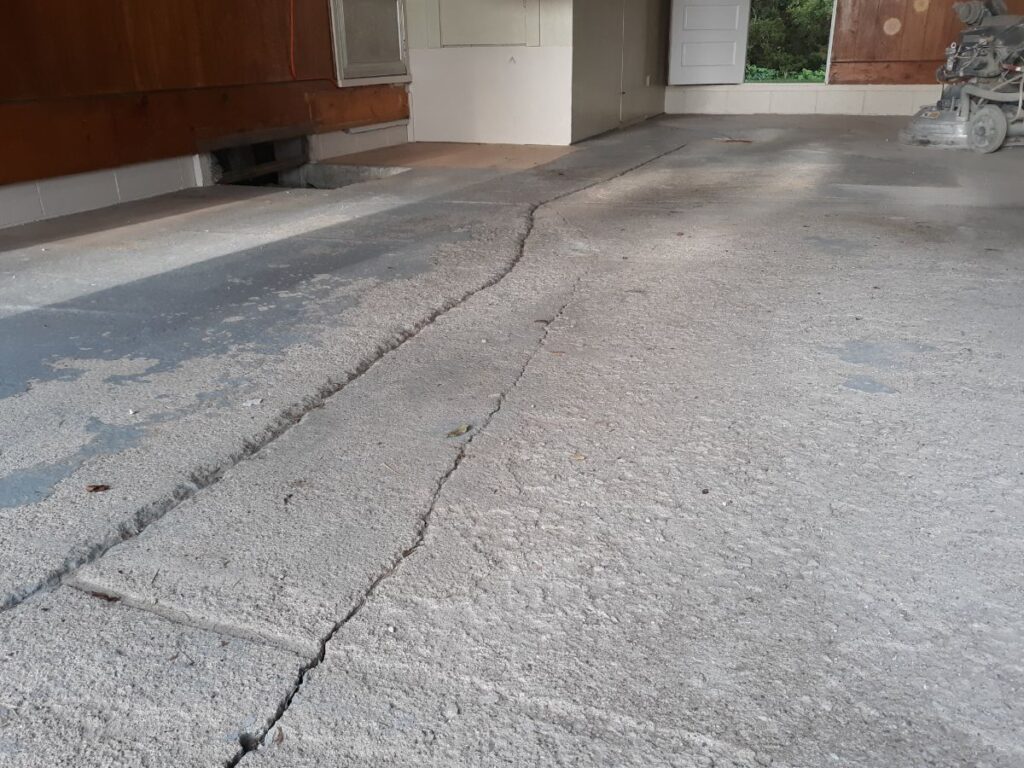
The Problem with Epoxy
Epoxy, a 2-part resin that is often applied as a concrete coating, is often sold as a quick fix, but it’s simply too brittle for Upstate winters. These days, it’s the “cheap” option, and it’s certainly no longer the go-to for professional concrete coatings.
Here’s why.
Once epoxy hardens, it behaves more like glass than a coating meant for a working garage. When your slab naturally moves with shifts in temperature, epoxy refuses to move along with it. Instead, it fractures. Tiny chips become bigger flakes, and before long, salt and water work their way underneath. Once moisture gets beneath the surface, the bond is gone and the coating begins peeling up in sheets.
That’s why so many epoxy garage floors look good for the first season but start showing their flaws after the first real freeze–thaw cycle or their first few summers of high heat.
Polyaspartic’s Secret: Flexibility
Polyaspartic coatings are different. They are engineered with a built-in elasticity that allows them to move with the slab, just enough to handle the natural expansion and contraction of concrete.
Think of it less like brittle glass and more like a tough shield with just enough give to handle stress. That subtle ability to bend is what keeps the surface intact even as your concrete expands during a deep freeze and contracts when the thaw arrives.
This flexibility isn’t a weakness, it’s what makes the system last where epoxy fails. Plus, polyaspartic coatings keep their color even under direct sunlight. Unlike epoxy, they won’t fade, yellow, or chalk when your garage door stays open on a bright summer afternoon.
Winter-Ready Protection Beyond Cracks
A flexible surface is one thing. Real protection goes further.
Polyaspartic floors resist corrosive chemicals like road salt, snowmelt residue, and leaked motor oil. They shrug off winter grime without staining or softening. And because they’re UV-stable, they don’t discolor outdoors. That means a back patio or front entryway can look as good after five years of sun and snow as it did the week it was installed. Homeowners across Syracuse, Albany, and the Hudson Valley have seen the difference firsthand — polyaspartic surfaces stay consistent season after season.
A Faster Return to Service, Too
Nobody in Upstate NY wants to lose their garage for a week while a coating slowly cures.
With epoxy, that’s the reality: days of waiting, tarps, and caution tape.
Polyaspartic is faster. Within hours, you can walk across your floor. By the next day, you can pull your car back inside, snow tires and all. That quick turnaround makes a huge difference when storms are constant and parking outside simply isn’t an option.
Why Dream Floors Uses Polyurea + Polyaspartic For Professional Concrete Coatings in Upstate NY
At Dream Floors, we skip epoxy altogether.
Every installation starts with a polyurea base coat. Polyurea bonds deep into the concrete, filling the pores and creating a foundation that flexes along with your slab. Over top, we apply a polyaspartic finish coat that delivers chemical resistance, UV stability, and a clean polished look.
That two-part system is why our floors hold up through Albany’s icy winters, Schenectady’s heavy snow, and Hudson Valley’s wide seasonal swings. We’re based in Fort Plain, NY, and we serve homeowners and businesses throughout the region who are done with coatings that just don’t last.
Ready for a Floor That Outlasts Winter?
If your garage or basement floor is already showing cracks—or if you’re tired of sweeping up flakes of failing epoxy—let’s fix it for good.
Reach out to Dream Floors today for a free quote and see how our polyaspartic systems stand up to Upstate winters.

